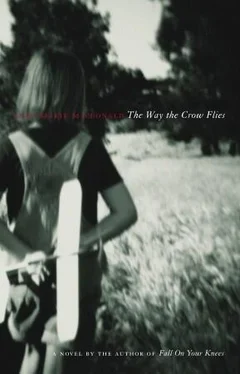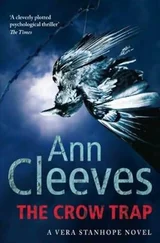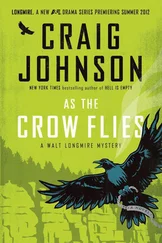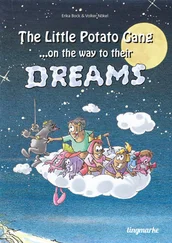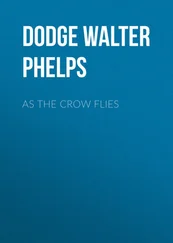Madeleine nods. She sees something flicker across Nina’s face — a smile — and feels a grin stretch the ends of her mouth. She tells the rest of the story through tears of mirth.
Christine was under a lot of pressure with her thesis. She screamed in Madeleine’s face, “You’re completely insensitive!” The demon entered Madeleine on cue and she began riffing— provoking , said Christine—“Madeleine, just grow up!”
“‘I’m ony two and a half yeahs owd,’” said Tweety Bird.
“Shut up, Madeleine, please!”
Madeleine laughed like Woody and kept going— some o’ my best woik, doc . The hands clamped around Madeleine’s neck and Christine cried and throttled her for a matter of seconds. There is psychodrama. This was psychocomedy.
Madeleine sums up, in her manly broadcaster voice, “It’s never just about the bean dip.”
“What did you do when she began to throttle you?” asks Nina.
“I just went … you know … really calm.”
“Calm?”
“Yeah. Kind of neutral, you know? Like waiting for it to be finished.”
“As though it was familiar.”
Madeleine stares at Nina. Feels her hands growing cool. “Why would you say that?”
“Because of the way you describe your reaction. You don’t seem to have been surprised.”
Madeleine takes a deep breath. “In a way I felt relieved—” she didn’t know she was going to say that.
Nina nods.
After a moment, Madeleine says, “So what do you make of it, doc? Am I, like, some kind of masochist? Apart from deciding to make a living as a comedian, which, it goes without saying….”
Finally Nina says, “I don’t think labels like ‘masochistic’ are very helpful. Especially for women — or anyone for that matter.”
“It’s my own fault, I press her buttons.”
Nina pours a glass of spring water from the pitcher.
“What do you think?” asks Madeleine.
Nina takes a sip, “I think Christine has a lot of buttons.”
Madeleine laughs.
“Have you ever told anyone about the assaults?”
Madeleine looks up as though she has been slapped. It has never occurred to her that the force of Christine’s grip around her neck, the thunk of her own skull against the wall, constitutes anything like abuse. Madeleine does benefits for women’s shelters. She is a grassroots feminist hailed by counterculturalistas and mainstream alike, a liberated lipstick lesbian in expensively distressed leather. “They’re not assaults,” she says.
“What do you think of them as?”
Madeleine’s mouth is dry but she doesn’t want to reach for the spring water. “Wow,” she drawls, “talk about a scandale,” and, resuming her news voice, “‘Feminist Egghead Assaults Funny-Girl Gal-Pal No Laughing Matter!’”
“Madeleine—?”
“‘Intrawoman Violence: The Hate That Dare Not Speak Its Name.’”
“Did I upset you with my choice of word?”
“Isn’t that why you chose it?”
Madeleine is aware that she is behaving predictably: denial, grandiosity, self-pity, self-loathing. The whole textbook. She rises and grabs her knapsack, muttering, “I don’t need this shit,” and leaves.
Madeleine has always admired Bugsy’s ability to escape down convenient rabbit holes and traverse the earth underground. That is what work has been for her. Always a number of things on the go, escape routes and connecting tunnels; head popping up in the midst of a field of carrots, gorging until she is shot at, then ducking in a puff of white smoke and speeding off, looking for that left turn at Albuquerque. It worked, professionally and personally, for quite a while. Then the “things” started happening, and therapy was supposed to be another rabbit hole. But it turns out this one wasn’t dug by Bugs. It belongs to the March Hare.
Maurice is seated at a dainty escritoire. He exudes a bland intensity. Beside him hangs a gilded cage from a stand. In it, a stuffed bird. His movements are small and lead nowhere, compelling and pointless. It becomes clear, however, that a decision has been accumulating behind his smudged glasses. Unhurriedly he opens a drawer in the tiny desk, withdraws a pair of panties, sniffs them, then returns them to the drawer.
That is the long and short of Maurice.
Sometimes he appears in historical garb — as a pilgrim on the Mayflower , or blinking tortoise-like from among the famous faces on Mount Rushmore. Combat soldier, Elmer the Safety Elephant, hippie. Always the glasses and grey suit predominate, with one or two touches — Quaker Oats hat; machine gun and reefer; stop sign, peace sign.
His inertia prevails regardless of what is occurring around him: the fall of Rome, the butter scene from Last Tango in Paris , the assassination of John F. Kennedy. And whether facing a high-noon duel or bounding weightlessly over the lunar surface, glasses glinting through the window of his helmet, Maurice always knows where to find the panties — in Ben Cartwright’s saddlebag, under a moon rock — and, invariably, he sniffs them.
He has become a cult figure. One of those characters who break free of their creators; Madeleine recently overheard a teenager on the subway say in tones of delighted disgust, “Ooo, that’s gross, that’s so Maurice!”

A BOY IN RED JEANS disappeared into a sunny day long ago, in 1963.
In 1973 he was quietly released from prison. He was not exonerated; he was granted parole. He had been a model prisoner and the authorities had determined that he posed no danger to the community, despite his steadfast refusal to admit guilt.
Oceans of ink were spilled on the Richard Froelich Case, which divided professionals and lay people alike. It became the subject of after-dinner speakers at coroners’ conventions and police conferences. The pathologist from the trial published articles and gave lectures; Inspector Bradley was promoted and addressed meetings of law enforcement agencies from across Canada and the U.S. Both men tirelessly shared their experience of the investigation and trial, intensifying their efforts when books and articles began to appear accusing “the system” of having failed a possibly innocent boy.
Over the years, whenever there was a story about a miscarriage of justice or debate about the death penalty, the Froelich case would be cited. Newspaper articles would appear alongside old school photographs of the boy and the victim. Eternally paired in grainy reproductions, their smiles more and more remote in time — his slicked-back hair from a bygone era, her Peter Pan collar. Older and older, and younger and younger.
As time went by, the case acquired the air of legend. Articles never failed to include certain “haunting details” such as the wildflowers and the cross of bulrushes found over her body. Her underpants over her face. And “the mysterious air force man,” the passing motorist who supposedly had waved from a blue Ford Galaxy, then failed to come forward. Journalists speculated that he might have been the real killer. In the late seventies, a weekly news magazine ran an article that featured an interview with a retired police officer who had been a constable on the case. Lonergan revealed for the first time that the boy’s father, “a German Jew named Henry Froelich,” had claimed to have seen a war criminal driving that same car in downtown London.
In the eighties a commission of inquiry was set up by the federal government to investigate the presence of war criminals in Canada. Parts of the report were never published, available only via the Access to Information Act, for it turned out that there were possibly thousands of war criminals in Canada — among them, concentration camp guards and an entire SS unit from Eastern Europe, members of which had claimed “conscription” and a healthy hatred of Communists among their credentials in their quest for Canadian citizenship.
Читать дальше
